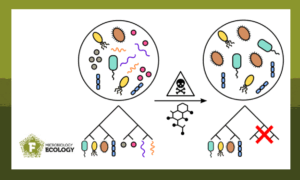Microbial communities play vital roles in the functioning of freshwater ecosystems, as they drive nutrient cycling, organic matter decomposition, and other processes vital to maintaining ecological balance. In response to changing environmental conditions, freshwater microbial communities adapt rapidly and reassemble into new structures. The study “Phylogenetic clustering of microbial communities as a biomarker for chemical pollution” in FEMS Microbiology Ecology aimed to investigate whether microbial communities themselves could serve as early warning indicators of pollution in aquatic ecosystems, as explained by Tom Smith. #FascinatingMicrobes
Microbes adapt to various environmental conditions
Freshwater ecosystems are increasingly threatened by chemical pollution. Nonetheless, detecting and tracking pollutants in these environments remains challenging, often requiring time-consuming and costly methods.
Within these environments, microbial communities are highly dynamic, responding and restructuring according to changing environmental conditions. Their changing composition may thus offer a powerful signal for ecological disturbance, such as that caused by pollution.
To investigate this idea, the study “Phylogenetic clustering of microbial communities as a biomarker for chemical pollution” in FEMS Microbiology Ecology asked whether aquatic microbes behaved in predictable ways when exposed to chemical stress.
For this, the authors used microbial samples from Icelandic streams, which were supposedly untouched by human activity and thus pollutants. They exposed both individual bacterial isolates and whole microbial communities to 168 agricultural and industrial chemicals which impact microbes unintentionally and unspecifically.
Evolutionary relatedness predicts sensitivity to pollution
Closely related bacterial taxa often responded similarly to the same chemicals. For example, the insecticide Abamectin strongly inhibited all three representatives of the genus Arthrobacter, while all 14 members of the Phylum Pseudomonadota tested were unaffected. This showed that bacterial responses to pollution seem to happen in a structured and evolutionary meaningful way.
These effects were also strongest when a chemical affected only a portion of the community, leaving enough variation to detect structured responses. This means that the evolutionary relationships between microbes can help predict how they would respond to certain types of chemical stress.
A strong pattern of nestedness was also present in the responses of bacterial taxa – some chemicals showed broad-spectrum effects as they inhibited nearly all bacteria. Other chemicals, however, affected only a subset.
The more impactful chemicals, hexachlorophene and dichlorophen, fenazaflor, dodin, fluazinam and captan, tended to cause consistent shifts in whole microbial communities, reducing both diversity and growth. Despite these chemicals being of different natures, they seemed to similarly impact the compositions of the communities. This suggests that there are more sensitive taxa that are lost from the community in response to any type of disturbance, while the more resilient taxa would persist.
Affected communities also showed increased phylogenetic clustering, indicating that certain evolutionary lineages were disproportionately affected – a hallmark of environmental filtering.

Scalable, phylogeny-informed biomonitoring for environmental pollution
Phylogenetically related species reacted to the pollutants similarly, resulting in communities shifting in predictable and structured ways. These community-level responses could be even captured using simple, taxonomy-free metrics, which do not require identification of individual taxa.
This approach thus becomes well suited for high-throughput biomonitoring applications. Paired with portable sequencing technologies, it could offer rapid, in situ assessments of water quality.
In summary, the findings suggest that microbial communities respond to pollution in a structured and evolutionarily meaningful way. By harnessing these patterns, we may be able to move toward a new generation of bioindicators that are both scientifically robust and operationally scalable, helping to safeguard ecosystem health in a rapidly changing world.
- Read the article “Phylogenetic clustering of microbial communities as a biomarker for chemical pollution” by Smith et al. (2025) in FEMS Microbiology Ecology

Tom Smith is an environmental microbiologist and postdoctoral researcher at Imperial College London. His research combines experimental approaches with high-throughput sequencing and ecological modelling to explore how microbial communities assemble, adapt, and function in changing environments. Tom is particularly interested in linking microbial diversity to ecosystem processes and harnessing microbes to develop sustainable solutions to global environmental change.
About this blog section
The section #FascinatingMicrobes for the #FEMSmicroBlog explains the science behind a paper and highlights the significance and broader context of a recent finding. One of the main goals is to share the fascinating spectrum of microbes across all fields of microbiology.
| Do you want to be a guest contributor? |
| The #FEMSmicroBlog welcomes external bloggers, writers and SciComm enthusiasts. Get in touch if you want to share your idea for a blog entry with us! |
